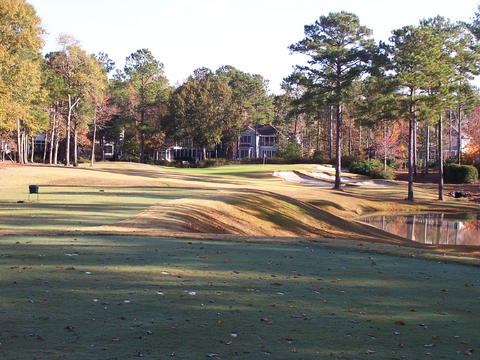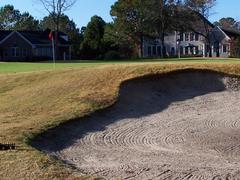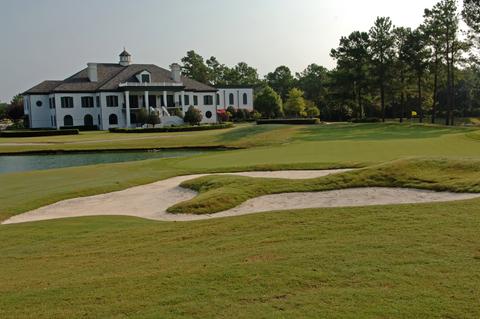
In just the last year, Porters Neck's Tom Fazio designed course has gone from good to excellent thanks to the investments the club made. (Photo courtesy of Porters Neck)
It is a challenging and scary proposition to take a golf club private. First, you need a governing board with the backbone to make an investment in the course up front, before membership rolls are filled. There's a reason you don't see marketing lines like, "If you join, we'll use your money to improve the golf course." Then you need to communicate, without being too stuffy, that privacy brings a certain amount of privilege not found at daily fee courses, and that the privilege is worth the price of initiation. Simple math is working against you; a $30,000 initiation fee divided by a $70 daily fee at a good public course works out to a decade worth of golf elsewhere.
That is the challenge that Porters Neck Country Club, about 12 miles northeast of Wilmington, NC, is facing. Although the club is being coy about its intentions, all signs point to a transition to  exclusive status. Greens fees for non-members have been raised to $110 and up, the club is in its second contract with a marketing firm that specializes in attracting new members, and the golf membership rolls are nearing 400, certainly a good number for an 18-hole course. The club's members, who took over from the developer in 2004, invested aggressively and smartly, spending $1 million in 2006 to restore and upgrade the terrific greens on the Tom Fazio layout, improving tee and fairway grasses as well as the drainage systems that support them, and enhancing the practice facilities (they added another $200,000 for new lighted tennis courts). We played the course before the renovations and after, and the money was well spent in our estimation.
exclusive status. Greens fees for non-members have been raised to $110 and up, the club is in its second contract with a marketing firm that specializes in attracting new members, and the golf membership rolls are nearing 400, certainly a good number for an 18-hole course. The club's members, who took over from the developer in 2004, invested aggressively and smartly, spending $1 million in 2006 to restore and upgrade the terrific greens on the Tom Fazio layout, improving tee and fairway grasses as well as the drainage systems that support them, and enhancing the practice facilities (they added another $200,000 for new lighted tennis courts). We played the course before the renovations and after, and the money was well spent in our estimation.
Over time, we have found that Tom Fazio designs the most consistently good routings of any architect. On otherwise excellent courses, some holes by Nicklaus and Dye just make you scratch your head at how odd or brutal they are (or both). We've yet to find a clunker among the dozen or so Fazio courses we've played in the two years. He may not provide the drama of the others, but neither does he provide any unpleasant surprises. [Continued; click below]
So it is at Porters Neck, a beguilingly "normal" routing with plenty of opportunities for challenging drives and approach shots to those remade greens that we'd love to have a shot when they are cut lower for even faster speeds (they were medium fast on the January day we played). A panel of 130 golfers and golf writers commissioned by North Carolina magazine voted Porters Neck the fifth best course on the North Carolina coast, high praise when you consider the size and quality of the competition.
Fairway bunkers at Porters Neck are large - no surprise there for Fazio aficionados - but they are only in play from the men's tees for those who bang the ball beyond 225. Bunkers at greenside are large and deep, and they give back plenty of lip. Fairways are generously contoured, rolling but not funneled. This is a layout for everyday play, its slope rating from the men's tees at 6,700 yards a reasonable 128, and 137 from the back tees (7,100 yards). Women playing from the 5,600 yard tees will find Porters Neck especially enjoyable as most of the greens are accessible with well-placed approach shots. 
We could have done without the posts in the middle of the fairways 100 yards from the greens; they held two bottles of a grass seed and sand mixture and indicated the exit points for carts. We find these stations add clutter to the middle of the fairways and ruin the visual sweep up to the green. Most players ride carts and the carts can hold two bottles of seed. Good enough.
Dues for full golf membership are reasonable at $385 per month and include access to the club's five lighted clay tennis courts, swimming pool, fitness center and dining in the well-appointed clubhouse.
Porters Neck Plantation's only real competition among golf communities in the area is Landfall, the huge community a few miles closer to Wilmington that includes 27 holes of Jack Nicklaus and 27 holes of Pete Dye golf. Golf there is fully private. Both communities maintain 24-hour security gates but Porters Neck gives off a more neighborhood vibe. Houses are on fair-sized lots but not large by any stretch, whereas Landfall's large homes sit on comparatively large lots, many of them with less than mature landscaping. The developers of Porters Neck, The Charter Building Group, were careful with the trees and other plantings, and few of the homes in the community are fully exposed to the elements. Retirees mostly were the early purchasers of homes in the Porter's Neck neighborhood, but now they are reaching an age at which they are downsizing and moving out.
Because of the capriciousness of Wilmington traffic, the commute from Porter's Neck to city center, just 12 miles away, runs anywhere from 15 to 35 minutes, and until recently, the community was considered "out there" by many Wilmingtonians. But by big city standards, a half-hour commute is no big deal, and those who live in Porters Neck see the pesky traffic problems as a small price to pay for access to a vibrant and up and coming city.
Most of Porters Neck has been built out, and we noted a number of homes under construction on the relatively few remaining lots. The community offers a mixed bag of real estate options, with a predominance of brick and stucco homes. We noticed only a small handful that were sided with cedar or hardy plank. About 40% of the community is made up of large houses on large lots (1/2  acre and up); the rest of the community is divided pretty much evenly between small houses (less than 2,200 square feet) on small lots and large houses on small lots. Prices are toward the high end for the Wilmington area, which is to say that you can spend as much as a few million dollars for a 6,000 square foot home with a view out to Wrightsville Beach and the Atlantic Ocean, or as little as $350,000 for a modest patio-style home. Most typical is the 3,000 square foot home on about a half acre of land and selling from between $500,000 and $650,000. If you were to purchase one of the few remaining golf course lots for between $250,000 and $350,000, count on $200 a square foot in construction costs.
acre and up); the rest of the community is divided pretty much evenly between small houses (less than 2,200 square feet) on small lots and large houses on small lots. Prices are toward the high end for the Wilmington area, which is to say that you can spend as much as a few million dollars for a 6,000 square foot home with a view out to Wrightsville Beach and the Atlantic Ocean, or as little as $350,000 for a modest patio-style home. Most typical is the 3,000 square foot home on about a half acre of land and selling from between $500,000 and $650,000. If you were to purchase one of the few remaining golf course lots for between $250,000 and $350,000, count on $200 a square foot in construction costs.
Porters Neck Golf Club is making all the right moves to fill out its membership and join the ranks of the few other private clubs in the area. The surrounding community is mature with a strong neighborhood feel.
If you are interested in Porters Neck or the Wilmington area, please let us know. We have a great real estate contact in the area who knows all the local golf course communities, and we will be happy to refer you. Also, this review gives you a taste of what you can expect from our HomeOnTheCourse advisory newsletter, which will be available in the coming days on an annual subscription basis for just $39. That's six information-packed issues for less than a round of golf at the local muni. Watch this space for the debut of HomeOnTheCourse soon.

Sip a cocktail behind the Porters Neck clubhouse and watch your friends make the difficult approach shot to the home hole. (Photo courtesy of Porters Neck)



